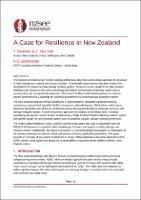A Case for Resilience in New Zealand

Download
Date
2024-04-09Authors
Beetham, Tessa
Zimmerman, Reid
Stratford, Cain
Metadata
Show full item recordAbstract
The concepts of resilience and holistic building performance drive the seismic design approach for structures with national significance or special post-disaster functions. Although considerable advancements have been made in the development of resilient and low damage building systems, seismic design to the New Zealand building code focuses on life safety and collapse prevention, with little consideration for minimising damage, repair costs or recovery times. Moreover, the lack of New Zealand based guidance to measure seismic performance of buildings is a challenge for quantifying resilience in a meaningful and consistent manner.
The new Archives Building belongs to this category of national significance, comprising a purpose-built specialist facility to house New Zealand’s Taonga. Client-driven performance objectives demanded state-of-the-art solutions to achieve ambitious business continuity, recovery, and damage mitigation targets. A multi-disciplinary approach was adopted by the design team, including quantifying site-specific seismic hazard, implementing a Triple Friction Pendulum Bearing isolation system, and specific design for non-structural systems such as partitions, facades, storage shelving and building services.
The United States Resiliency Council (USRC) rating system was used in conjunction with FEMA P-58 framework to quantify holistic building performance with respect to safety, damage, and recovery. Additionally, the recently released ATC-138 methodology was adopted in computation of the recovery dimension to identify critical path systems affecting total building downtime. This paper presents an overview of key aspects of resilience in design, before detailing a case-study application of the USRC rating system and discussing its applicability to quantify seismic resilience within a New Zealand context.
